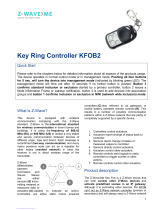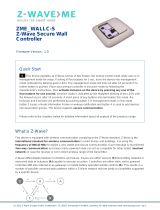Page is loading ...

004407$–$Z-Wave$CO$Sensor$(EU$version)$
Quick Start
This device is a Z-Wave sensor reporting Carbon Monoxide Danger. Pressing the button
'Inclusion Button' for one second adds (includes) and removes (excludes) the device from/to
the Z-Wave network.
Please refer to the chapters below for detailed information about all aspects of the product.
Product$description$
This product combines a certified carbon monoxide detector with a plug-in Z-Wave module to form a
wirelessly reporting smoke sensor plus wirelessly controllable indoor siren. The carbon monoxide
detector is certified according to EN 50270:1999,EN 60335-1:1994 as well as EN 50291:2001 and
satisfies all contemporary legal requirements.
The High-End carbon monoxide detector offers a test button conveniently accessible even with a
broom stick when mounted on the sealing. Three colored LEDs on the device indicate Alarm, Error
and Battery Level. The Alarm conditions as well as the actual CO level – measured in ppm – are
reported wirelessly using Z-Wave. Additionally a group of actuators can be controlled using the BASIC
command class in case the CO alarm triggers. Two configuration parameters define what command to
be sent in this case.
The device is a secure Z-Wave Plus device and can be used in one wireless Z-Wave network with
other certified devices regardless of origin and brand. It supports secure communication if the central
controller supports secure communication as well. Even if included securely the device is able to
communicate unsecured with devices included unsecure using the association groups 2. Beside the
Carbon monoxide danger alarm the device will also report a tamper alarm if the sensor is removed
from the mounting base. As a Z-Wave device is will make use of other mains-operated devices in the
network as routers if the wireless situation requires so.
Installation$Guidelines$
Please refer to the installation guide of the carbon sensor
attached for information about how and where the carbon
monoxide sensor should be installed. Please note that the
carbon monoxide sensor will also work stand-one even if not
Z-wave network is present
• The first step is to mount the mounting base on the
desired place in the home using screws.
• Remove the battery isolation strip from the wireless
module. The red LED will start blinking.
• Include the Sensor into your existing Z-Wave based
Smart Home Network using the 'Inclusion button'.
• Place the Detector on the mounting base and turn
clockwise. Now the detector is armed.
• Battery Change: The battery of the wireless module will
be empty much earlier than the 10 years soldered in
battery of the Sensor. To replace the battery, remove the
detector, pull off the wireless module from the smoke sensor. Then you can replace the 1/2 AA
battery and re-plug the wireless module.

Behavior$within$the$Z-Wave$network$
On factory default the device does not belong to any Z-Wave network. The device needs to join an
existing wireless network to communicate with the devices of this network. This process is
called Inclusion. Devices can also leave a network. This process is called Exclusion. The primary
controller of the Z-Wave network initiates both processes. This controller will be turned into exclusion
respective inclusion mode. Please refer to your primary controllers manual on how to turn your
controller into inclusion or exclusion mode. Only if the primary controller is in inclusion or exclusion
mode, this device can join or leave the network. Leaving the network - i.e. being excluded - sets the
device back to factory default.
If the device already belongs to a network, follow the exclusion process before including it in your
network. Otherwise inclusion of this device will fail. If the controller being included was a primary
controller, it has to be reset first.
Pressing the button 'Inclusion Button' for one second includes the device. If the button is pressed for at
least 2 seconds the inclusion will be done without the (Security Command Class). A single click on the
button will exclude the device.
Operating$the$device$
There is no defined level of Carbon monoxide that will result in an alarm. The danger of CO is a result
of the total level of CO in the air plus the duration of exposure. An Z-Wave alarm will be sent out when
one of the following conditions where met:
• CO level above 43 ppm for a duration of 60 minutes
• CO level above 80 ppm for a duration of 10 minutes
• CO level above 150 ppm for a duration of 2 minutes
The alarm will be sent to the central controller plus any device listed in the association group 2.
Additionally the alarm can be used to switch any other Z-Wave controllable actuator such as a Switch,
a Dimmer or even a Door Lock that is placed in association group 3.
The wireless module will also report a low (wireless module) battery warning and a tamper alarm on
and off when the mains device is place on or removed from the mounting base. Please note that the
battery level of the main detector is not reported since this battery can’t be replaced anyway.
Note: All communication of the wireless module is performed with application level security if the
device was included securely and all communication partners support secure communication as well.
In case a non-secure device is associated for switching on smoke alarm, the smoke detector will
detect this and change its communication style with this very device to non-secure. This process
happens one time and will take about 20 seconds. This delay will happen on first communication only.
Factory reset
To do a factory reset press the button on the bottom of the device for at least 10 seconds. This
procedure should only be used when the primary controller is inoperable.
Firmware Update
Once the firmware update process has started (wakeup first by single push the button) double click
the Z-Wave button to confirm firmware update process.
Support for Command Class Basic
The device supports the generic Z-Wave command class “Basic”. The device will ignore any SET
command but return the status of the sensor on a GET command (triggered=0xff, idle=0x00).

Alarm Messages
The device will issue the following (unsolicited) alarm messages:
- CO Danger Detected (this message will also be issued when the Test button is pressed
- Low Battery Alarm (when the battery of the wireless modules goes low)
- Tamper Detected (on, when the co detector head is removed from the base; off, when the
detector head is mounted to the base)
- Malfunction (issued, when the Detector Main Head detect a malfunction of CO detection)
Node$Information$Frame$
The Node Information Frame is the business card of a Z-Wave device. It contains information about
the device type and the technical capabilities. The inclusion and exclusion of the device is confirmed
by sending out a Node Information Frame. Beside this it may be needed for certain network operations
to send out a Node Information Frame.
A simple click on the 'Inclusion Button' sends a NIF.
Associations$
Z-Wave devices control other Z-Wave devices. The relationship between one device controlling
another device is called association. In order to control a different device, the controlling device needs
to maintain a list of devices that will receive controlling commands. These lists are called association
groups and they are always related to certain events (e.g. button pressed, sensor triggers, ...). In
case the event happens all devices stored in the respective association group will receive a common
wireless command.
Association Groups:
1
Lifeline (max. nodes in group: 10)
2
Switching Command when Alarm (max. nodes in group: 10)
Configuration$Parameters$
Z-Wave products are supposed to work out of the box after inclusion, however certain configuration
can adapt the function better to user needs or unlock further enhanced features.
IMPORTANT: Controllers may only allow configuring signed values. In order to set values in the range
128 … 255 the value sent in the application shall be the desired value minus 256. For example: to set
a parameter to 200 it may be needed to set a value of 200 minus 256 = minus 56. In case of a two
byte value the same logic applies: Values greater than 32768 may needed to be given as negative
values too.
Value of On-Command (Parameter Number 1, Parameter Size 1)
Value
Description
0 — 99
(Default 99)
Value of Off-Command (Parameter Number 2, Parameter Size 1)

Value
Description
0 — 99
(Default 0)
Command$Classes$
Supported Command Classes
• Basic (version 1)
• Binary Sensor (version 2)
• Association Group Information (version 1)
• Device Reset Locally (version 1)
• Z-Wave Plus Information (version 2)
• Configuration (version 1)
• Alarm (version 5)
• Manufacturer Specific (version 2)
• Multilevel Sensor (version 5)
• Powerlevel (version 1)
• Firmware Update Meta Data (version 3)
• Battery (version 1)
• Association (version 2)
• Version (version 2)
• Wakeup (version2)
Controlled Command Classes
• Basic (version 1)
Z-Wave$Technical$Data$
!
Battery Type
12 * AAA resp. ½ AA plus internal Lithium
Frequency
868/869 MHz (SRD Frequency Band according EN300220)
Wireless Range
up to 100 m outdoor, 40 m in buildings
Explorer Frame Support
Yes
SDK
6.51.6
Device Network Role
Sleeping Reporting Slave (SRS)
Device Type
Sensor
Routing
No
Firmware Version
1.0
/






